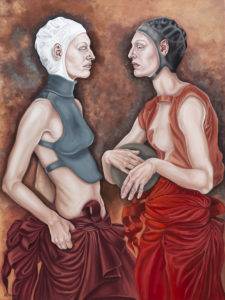About the exhibition:
The Dual Nature of Femininity
For many months I have been observing the strong reactions of art enthusiasts to Dorota Kuźnik's output. Her paintings leave no one indifferent, myself alike. Indeed, it triggers the need to comment and share the reflexion. Sometimes the remarks are extremely emotional, intimate even, almost confessional. At first, it was a shock for me, that Dorota Kuźnik's painting was deeply moving for both women and men. Moving enough, that they not only contemplate it, but also decide to broaden their collections by purchasing further paintings by the artist.
Kuźnik's entire artistic world revolves around femininity. What is a woman like, how does she see herself, how is she perceived by the pressuring society trying to form her. The artist uses archaization and stylization to discuss timeless and contemporary issues. We are living in quite a conservative country, where society and family have certain expectations towards a woman, like to find a well respected job, get married and give birth. Of course, she can follow a different path, but she will often deal with unfavorable comments, and may be left stranded, alone with her problems, unable to count on any support. In this situation, one can get lost, not be sure of their beliefs, not find happiness and even get depressed. She is expected to have one, "proper and expected" face for the world and to hide the internal drama. Often, Dorota's paintings express the dual nature of femininity. About our bright and dark side. Almost every painting is also a portrait. The facial features of the artist's models are enchanted with the stories of their lives and their choices.
It would be banal to write that Dorota Kuźnik's painting is characterized by her perfect workshop. Nonetheless, that is true. She favors use of prop and costume. The artist paints every picture with great reverence. In an almost sensual way, she feels the surface of fabrics, wood and metal. Her depiction of detail makes it difficult to keep yourself from reaching out to touch it. This gesture is often provoked by the artist's use of collage elements. She pastes velvet borders - a material that indeed forces the touch. This is a distinctive game.
Women in Dorota's paintings are, on one hand, inaccessible and monumental, and on the other hand, internally fragile. We sense that under the mask of indifference, under the figure tightened with a corset, emotions are swirling. Sometimes these emotions literally billow in women's robes. They arm themselves against the world and at the same time push it away.
The universe of femininity showed by Dorota, is a game of "attracts and repels", "touch, but do not move", "I want to, but I am afraid." Sound familiar? Many of us, maybe not only us women, but of us people in general, know this problem. We would like to do something, change something in life, but we are too afraid to go out into the world and face something unknown. I think this is not only a woman's problem. Especially today. That is why - I suppose - Dorota's painting also appeals to men so strongly. They rarely admit to certain things, but they share similar fears and anxieties. All of us dictate the expectations of our society and impose restrictions, and the world shows many other possibilities, but our decisions are fraught with fears of regret and responsibility. Dorota's painting illustrates these dilemmas. It is for those who have made their decisions already and for those who are on the threshold.
Dorota Kuźnik made her decision. Very late, she decided on a formal painter career, she graduated from university, and she quit safe, full-time work. She freed herself from limitations in favor of what has always been her true path. This is the reason why, beyond the undeniable talent, her painting is so emotionally mature and reliable.
Agnieszka Gniotek










